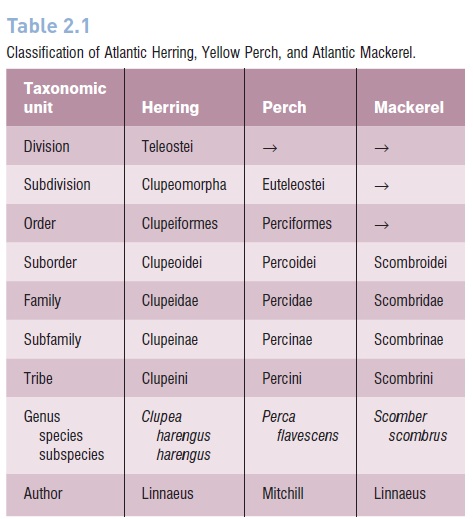Chapter: The Diversity of Fishes: Biology, Evolution, and Ecology: Systematic procedures
Units of classification - The Diversity of Fishes
Units of classification
Systematists use a large number of units to show relationshipsat different levels. Most of these units are not necessary except to the specialist in a particular group. For example, ray-finned fishes fall into the following units: kingdom: Animalia; phylum: Chordata (chordates); subphylum:Vertebrata (vertebrates); superclass: Gnathostomata(jawed vertebrates); grade: Teleostomi or Osteichthyes(bony fishes); and class: Actinopterygii (ray-finned fishes). classification of three representative fishes is shown instable 2.1.
Table 2.1
Classification of Atlantic Herring, Yellow Perch, and Atlantic Mackerel

Note the uniform endings for order (-iformes), suborder(-oidei), family (-idae), subfamily (-inae), and tribe (-ini). Also, note that the group name is formed from a stem plus the ending. This means that if you learn that the Yellow Perch is Perca fl avescens, you can construct much of the rest of classification by adding the proper endings. Percidae is the family including the perches, Percoidei is the suborder of perch like fishes, and Perciformes is the order containing the perchlike fishes and their relatives.
It is conventional to italicize the generic and specificnames of animals and plants to indicate their origin from Latin (or latinized Greek or other language). Generic names are always capitalized, but species names are always in lowercase (unlike for some plant species names). The names of higher taxonomic units such as families and orders are never italicized but are always capitalized because they are proper nouns. Sometimes it is convenient to convert the name of a family or order into English (e.g., Percidae intopercid, Scombridae into scombrid), in which case the nameis no longer capitalized. Common names of fishes have notusually been capitalized in the past but this has recently changed, recognizing that the names are really proper nouns (Nelson et al. 2002). Capitalizing common names avoids the problem of understanding a phrase like “green sunfish”. Does this mean a sunfish that is green or does it refer to the Green Sunfish, Lepomis cyanellus?
It is also conventional to list higher taxa down to orders in phylogenetic sequence, beginning with the most primitive and ending with the most advanced, reflecting the course of evolution. This procedure has the additional advantage that closely related species are listed near each other, facilitating comparisons. As knowledge about the relationships of organisms increases, changes need to bemade in their classification. An instructive example of justification for changing the order in classification was presented by Smith (1988) in a paper entitled “Minnows first, then trout”. Smith explained that he placed the minnows and relatives (Cypriniformes) before the trouts and salmons (Salmoniformes) in his book on the fishes of New YorkState to reflect the more primitive or plesiomorphic phylogenetic position of the Cypriniformes.
Related Topics